I am trying to solve the following inequality constraint:
Given time-series data for N stocks, I am trying to construct a portfolio weight vector to minimize the variance of the returns.
the objective function:
min w^{T}\sum w
s.t. e_{n}^{T}w=1
\left \| w \right \|\leq C
where w is the vector of weights, \sum is the covariance matrix, e_{n}^{T} is a vector of ones, C is a constant. Where the second constraint (\left \| w \right \|) is an inequality constraint (2-norm of the weights).
I tried using the nloptr() function but it gives me an error: Incorrect algorithm supplied. I'm not sure how to select the correct algorithm and I'm also not sure if this is the right method of solving this inequality constraint.
I am also open to using other functions as long as they solve this constraint.
Here is my attempted solution:
data <- replicate(4,rnorm(100))
N <- 4
fn<-function(x) {cov.Rt<-cov(data); return(as.numeric(t(x) %*%cov.Rt%*%x))}
eqn<-function(x){one.vec<-matrix(1,ncol=N,nrow=1); return(-1+as.numeric(one.vec%*%x))}
C <- 1.5
ineq<-function(x){
z1<- t(x) %*% x
return(as.numeric(z1-C))
}
uh <-rep(C^2,N)
lb<- rep(0,N)
x0 <- rep(1,N)
local_opts <- list("algorithm"="NLOPT_LN_AUGLAG,",xtol_rel=1.0e-7)
opts <- list("algorithm"="NLOPT_LN_AUGLAG,",
"xtol_rel"=1.0e-8,local_opts=local_opts)
sol1<-nloptr(x0,eval_f=fn,eval_g_eq=eqn, eval_g_ineq=ineq,ub=uh,lb=lb,opts=opts)

